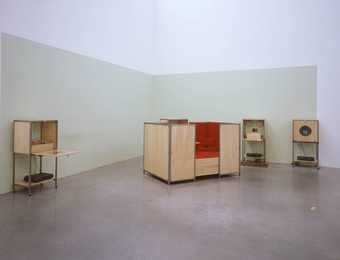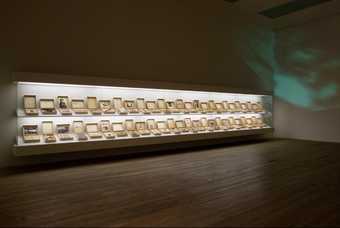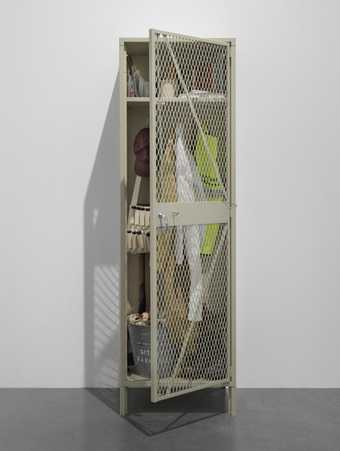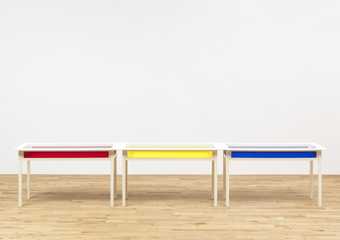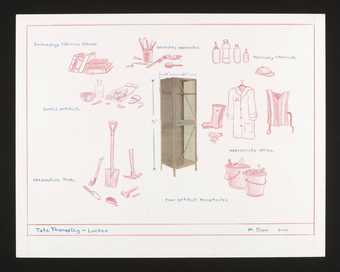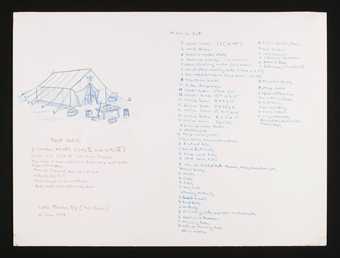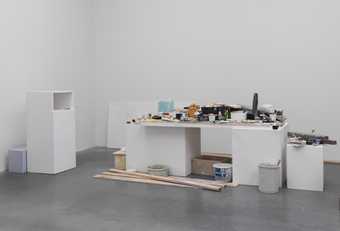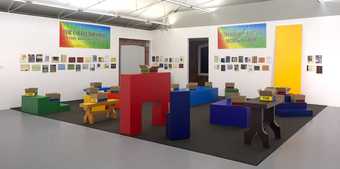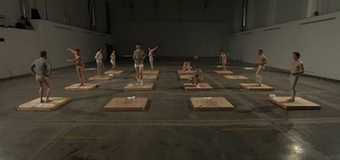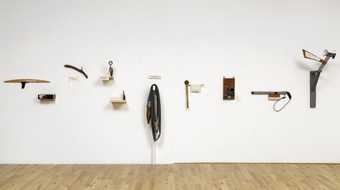In Tate Modern
- Artist
- Mark Dion born 1961
- Medium
- Wooden cabinet, porcelain, earthenware, metal, animal bones, glass, 27 prints and 2 maps
- Dimensions
- Unconfirmed: 2660 × 3700 × 1260 mm
- Collection
- Tate
- Acquisition
- Purchased with assistance from private benefactors 2000
- Reference
- T07669
Summary
This text discusses two related works, Tate Thames Dig 1999 (T07669) and Tate Thames Dig - Locker 2000 (T07670).
During the summer of 1999, U.S. artist Mark Dion and a team of volunteers drawn from local groups combed the foreshore of the Thames at low tide along two stretches of beach at Millbank and Bankside, near the Tate Gallery (now Tate Britain) and Bankside Power Station, which would become Tate Modern the following year. As with Yard of Jungle 1992 (Museo Arte Moderna, Rio de Janeiro), where he literally removed and examined a yard of jungle floor, Dion focused on a natural, historical constant. In this case, he turned to the banks of the River Thames, looking for fragments of individual and ephemeral histories. London's location, its growth and its fortunes can be attributed to the Thames. The two sites yielded a wide variety of artefacts and tokens of life as lined Millbank on the north shore of the Thames and Bankside on the south. Working over a number of days, Dion's team collected large quantities of items, including clay pipes, vividly decorated shards of delftware, oyster shells and plastic toys. The finds were then meticulously cleaned and classified in 'archaeologists' tents' on the Tate Gallery's lawn at Millbank during the summer of 1999.
First shown at the Tate Gallery as an Art Now installation between October 1999 and January 2000, the finds for Tate Thames Dig are presented according to location in a double-sided old-fashioned mahogany cabinet, alongside photographs of the beachcombers and tidal flow charts. There are also five 'treasure chests' which contain larger items, but which are not part of this work. Organised loosely according to type (such as bones, glassware, pottery, metal objects), the viewer finds them in seemingly unhistorical and largely uninterpreted arrangements. Antique items sit alongside contemporary items, ephemera and detritus are next to objects of value. Each is a material witness, performing the same function as a historical proof. This lack of distinction is an important aspect of Dion's approach and he resists the reading of history as a necessarily linear progression. The only differentiation is a geographical one, the two sites retaining their individual identities. The lack of historical categorisation suggests a subversion of standard museological practice. Viewers are free to create their own associations, to trace histories across time, not necessarily in a linear direction.
Tate Thames Dig - Locker did not form part of the original Art Now installation and stands as a kind of postscript in relation to the project. The work comprises a field locker filled with items belonging to or used by Dion. Its appearance contrasts with the solidity and solemnity of the double-sided mahogany veneer cabinet. The side panels and door of the locker are constructed from sturdy wire mesh, so that the contents are visible. It has the quality of a theatrical prop cupboard; the assembled objects and articles stand as attributes of the artist-archaeologist-collector. On the top shelf sit various items and a number of books, including S.J. Knudson's Culture in Retrospect: An Introduction to Archaeology. Hanging from pegs are Dion's orange boilersuit and cap, a Tate Modern site jacket, a specimen bag, and the white lab coat that he wore while camped on Millbank lawns. Alongside his boots on the floor, there are two rubbish-filled dustbins, labelled 'site 1 Millbank' and 'site 2 Bankside'. These suggest humorous connections with the Art Now treasure chests and prompt us to question the categories of disposable and valued.
Dion's practice incorporates aspects of archaeology, ecology and detection. His projects focus primarily on current issues surrounding the representation of nature and on the history of the natural sciences. Dion is simultaneously fascinated and repelled by the principles of taxonomy which have been used since the eighteenth century to classify and interpret the natural and man-made ephemera of the world. His principles are informed by the writings of Stephen Jay Gould, the contemporary evolutionary theorist, who points out that taxonomic systems do not provide objective criteria but are contingent upon our value systems and thus rooted within our social structures. By re-enacting the processes of scientific research, Dion questions the premises upon which these activities are based. His investigations have led him to construct laboratories and to embark on experiments and expeditions. An essential aspect of his methodology is collaboration with other artists, scientists, community groups, and both art and non-art institutions. His work can take the form of installation, sculpture, performance or film and video. Typically, these present a reworking of the orthodox procedures of collecting, identifying and classifying to suggest a more poetic and open-ended approach to interpretation.
Further reading:
Art Now 20: Mark Dion, exhibition leaflet, Tate Gallery, London 1999
Mark Dion, Tate Thames Dig: Beachcombing London's Foreshore, exhibition leaflet, Tate Gallery, London 1999
Tina Fiske and Giorgia Bottinelli
February 2002
Does this text contain inaccurate information or language that you feel we should improve or change? We would like to hear from you.
Display caption
Gallery label, August 2004
Does this text contain inaccurate information or language that you feel we should improve or change? We would like to hear from you.
Explore
- emotions, concepts and ideas(16,416)
-
- formal qualities(12,454)
-
- classification(114)
- found object / readymade(2,631)
- universal concepts(6,387)
-
- history(1,983)
- fine arts and music(3,982)
-
- photograph(522)
- cupboard(50)
- brick(56)
- map(110)
- bottle(289)
You might like
-
Andrea Zittel A-Z Comfort Unit with Special Comfort Features by Dave Stewart
1994–5 -
Susan Hiller From the Freud Museum
1991–6 -
Mark Dion Tate Thames Dig - Locker
2000 -
Langlands & Bell (Ben Langlands and Nikki Bell) Adjoining Rooms
1989 -
Mark Dion, J. Morgan Puett Mrs. Herbert Fowler, Anthropology
1999 -
Mark Dion, J. Morgan Puett Miss Amelia West, Botany
1999 -
Mark Dion, J. Morgan Puett Arabella Bell, Conchology
1999 -
Mark Dion Tate Thames (Locker)
2000 -
Mark Dion Tate Thames Dig (Two Banks)
1998 -
Mark Dion Two Banks
1998 -
Peter Fischli, David Weiss Untitled (Tate)
1992–2000 -
Allen Ruppersberg The Never Ending Book
2007 -
Jesse Aron Green Ärztliche Zimmergymnastik
2008 -
Jimmie Durham Untitled
1993–2012 -
Michael Rakowitz The Invisible Enemy Should Not Exist
2007–ongoing


